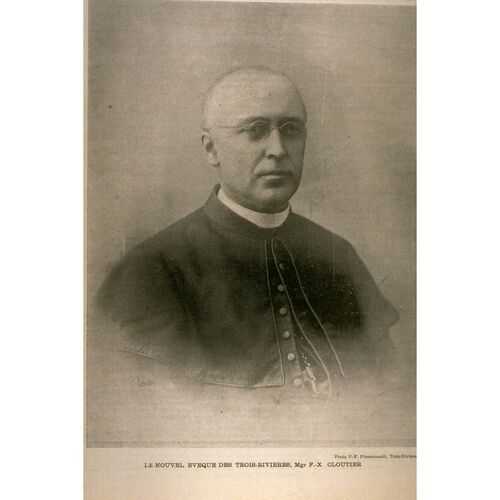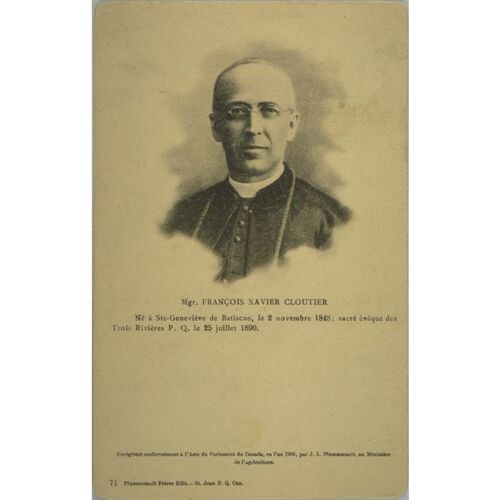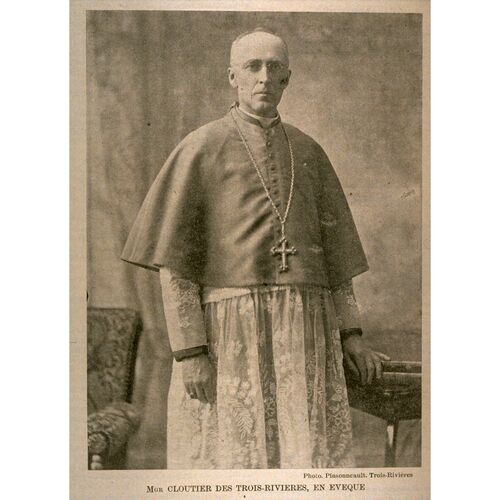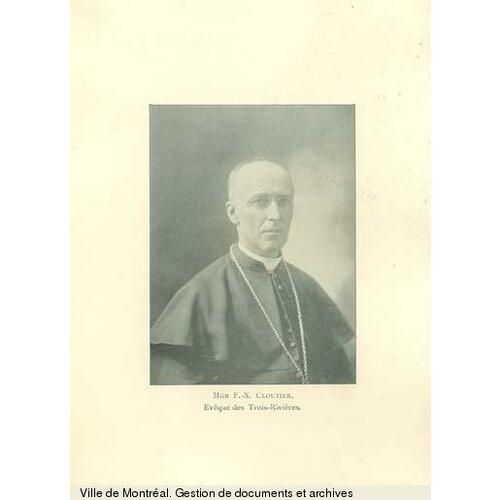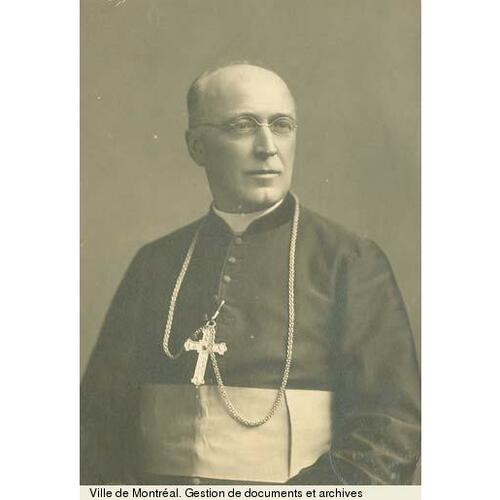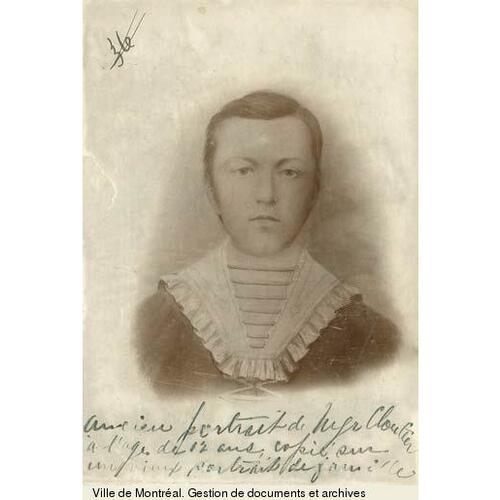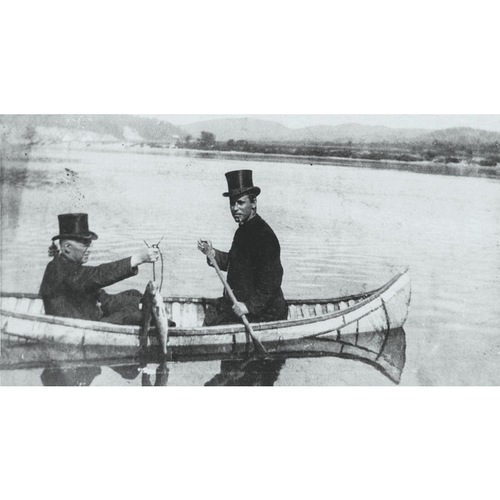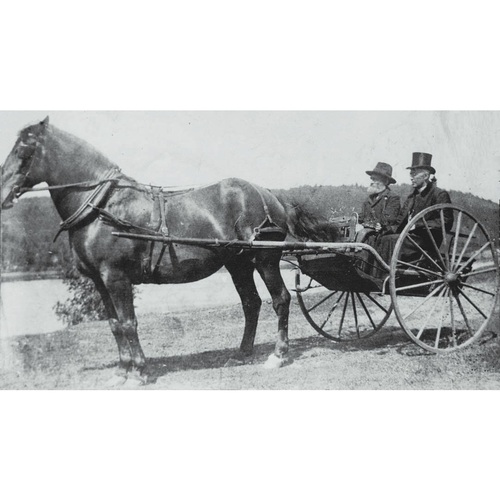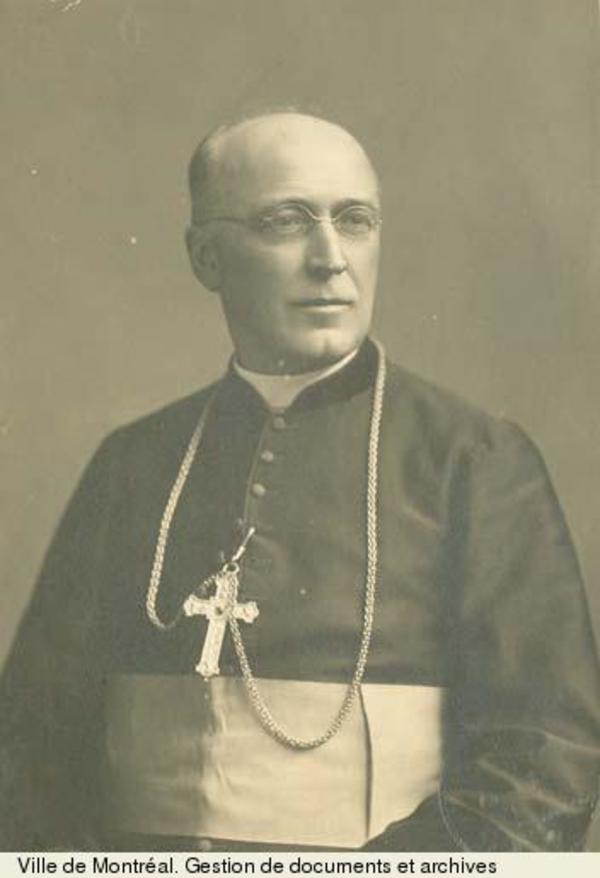
Source: Link
CLOUTIER, FRANÇOIS-XAVIER, teacher, Roman Catholic priest and bishop; b. 2 Nov. 1848 in Sainte-Geneviève-de-Batiscan, Lower Canada, son of Jean Cloutier, a farmer, and Olive Rivard; d. 18 Sept. 1934 in Trois-Rivières, Que.
Born into a “family of priests” from a rural area, François-Xavier Cloutier left his home parish in September 1861 to acquire a classical education at the Collège des Trois-Rivières, which would become a diocesan seminary in 1874, located at that time in what had been the governors’ residence during the French regime. The next 20 years of his life would unfold effectively within that institution. He was in his second year of philosophy when he donned the cassock. He taught while pursuing his theological studies, a common practice at the time among the clergy; once he became a bishop, however, he denounced the practice, which would not be ended until 1936. Cloutier was nearly 24 years old when he was ordained to the priesthood on 22 Sept. 1872. From 1870 he taught rhetoric and took on the additional role of headmaster in 1876. These developments took place before the eyes of his bishop, Louis-François Laflèche*, who as of 1874 lived in the new turreted seminary on Rue des Champs (Laviolette).
Laflèche was therefore well acquainted with Cloutier, whom he appointed curate of the cathedral parish in 1880 and chancellor in 1883. He made Cloutier his secretary and companion in the struggle that took him to Rome to contest the division of his diocese [see Elphège Gravel*; Calixte Marquis*]. The following year the bishop appointed him to the vicarage of Trois-Rivières. For 15 years Cloutier was officially curé of the cathedral parish but without the burden of the chancellor’s financial responsibilities. He became deeply involved in education and lay organizations, areas that had been developed by Laflèche. He was again living under the roof of the bishop, who designated Cloutier as his successor. He was elected as the third bishop of Trois-Rivières on 8 May 1899 and was consecrated in his cathedral on 25 July of that year by the archbishop of Quebec, Louis-Nazaire Bégin*.
The new bishop took over a small rural diocese faced with financial difficulties that had remained unresolved for some 15 years, but for which the industrial expansion of the region would soon provide a solution. Between 1899 and 1934 the number of parishioners increased from 60,568 to 132,440, distributed among 67 parishes in the latter year – 29 more than at the turn of the century. Although the number of priests had more than doubled, growing from 86 to 189, the ratio of ecclesiastical personnel remained at about one priest to every 700 parishioners. The diverse and growing needs of the diocese created new demands. Cloutier took several steps. He would convene a diocesan synod from 28 to 30 Aug. 1911 to familiarize its members with the new social realities. He also recruited religious congregations. In 1902 he gave the Oblates of Mary Immaculate responsibility for the parish of Sainte-Marie-Madeleine at Cap-de-la-Madeleine (Trois-Rivières) as well as for its Marian pilgrimage [see Luc Desilets*]. In 1911 he erected the parish of Notre-Dame-des-Sept-Allégresses in Trois-Rivières and placed it under the charge of the Franciscans, who also opened a branch of the Collège Séraphique de Montréal to train candidates for Franciscan life. Likewise, at Cloutier’s request, a small group of Dominicaines de l’Enfant-Jésus [see Philomène Labrecque*] from Quebec City founded the Dominicaines du Rosaire in Trois-Rivières in 1902. Beginning as servants of the clergy, they later took on work in education and social assistance. The following year the bishop also installed the Daughters of Jesus [see Marie Le Gallo], who would open a provincial house, a noviciate, and 26 schools during his episcopate. These teaching congregations joined more established groups, such as the Ursulines, who set up a normal school in 1908. Three years later came the Marist Brothers. Together, the 17 religious congregations the bishop brought to his diocese gave a new impetus to educational endeavours, thereby demonstrating how important this work was to him.
These communities also helped strengthen the movement for church membership at a time when almost all observed such religious practices as receiving communion at Easter and making their annual confession. As a result, at the turn of the 20th century emphasis was placed on the practice of frequent communion. Bishop Cloutier wished to go even further, however, and in 1904 the golden jubilee of the proclamation of the dogma of the Immaculate Conception provided him with the opportunity to carry out his wishes. He wanted to make the sanctuary at Cap-de-la-Madeleine, Notre-Dame-du-Cap, a centre of pilgrimage whose fame would increase beyond that which it had enjoyed throughout the diocese for the past four years. From then on he did everything possible to make the coronation of the statue of Our Lady of the Rosary the occasion for raising the sanctuary to the status of a national pilgrimage destination. This recognition was granted to him by the bishops at the first Plenary Council at Quebec City in September 1909.
It was also during this council meeting that Cloutier proclaimed, in Saint-Sauveur church, his views on the social ills brought about by industrialization and urbanization. He proposed to solve the problem posed by deteriorating working conditions through the restoration of Christian morality, Roman Catholic charitable works, a partnership between workers and employers by means of working-class corporations and other arrangements, and limited and targeted action by the state. Both in planning and in implementation, his ideas reflected the message of Rerum novarum, Leo XIII’s encyclical published in 1891.
At the beginning of the 20th century, Cloutier encouraged the growth of the Ligue du Sacré-Cœur in his diocese. This pious organization was devoted to uplifting morals. Its branches carried on the struggle against drunkenness and then against blasphemy. However, in 1910, acting on the bishop’s instructions, the organization would suddenly change direction, focusing on social issues such as the prevention of tuberculosis in poor and insalubrious areas. On a completely different level, it was no stranger to courting “good press.” To support the clergy in social action, however, Bishop Cloutier favoured the Third Order of St Francis of Assisi. This devoutly religious association, dedicated to the spiritual education of its members (they numbered 10,000 in 1916), began to concern itself with social realities. For example, at its monthly meetings in 1909 leaders dealt with the model of behaviour to be adopted by its members, employers, and workers, who all rejected international trade unions. Given its concerns, the Third Order Franciscans fully embraced the spirit of the encyclical. The association’s members, along with those of the Ligue du Sacré-Cœur, constituted the lay elite on which the bishop relied.
Communicating the diocesan church’s social action and methods was largely the responsibility of the weekly Le Bien public [see Joseph Barnard]. Founded in 1909 on Cloutier’s initiative, the periodical wholeheartedly supported the bishop’s decisions. As a promoter of diocesan charitable works, Le Bien public, having been integrated into the Catholic press’s network, took part in publicizing broad national campaigns against intemperance, public displays of immorality, and the practice of working on Sunday.
In 1912 the first social-action congress in the diocese of Trois-Rivières – initiated by Cloutier and attended by many members of the Ligue du Sacré-Cœur and the Third Order of St Francis of Assisi – created an opening for economic activities such as the establishment of credit unions and mutual-aid societies. This initiative proved both beneficial and inspirational for the cooperative circles. In Cloutier’s view, a good model to imitate was the Comptoir Coopératif de Montréal, founded in 1913. Its aim was to eliminate the middlemen between the producer and the consumer so that the latter might receive the best price. For Émile Cloutier – a nephew of the bishop of Trois-Rivières and a versatile priest in the service of the bishopric, who was educated in social Catholicism at the University of Louvain, in Belgium – the aim was to create a united federation of agricultural unions. Cooperative undertakings appeared throughout the rural parishes of the diocese of Trois-Rivières. The first clubs for farm women, created between 1915 and 1921, and the Union Catholique des Cultivateurs, which would take root in the diocese in 1924, would make other contributions to the movement.
At Cloutier’s urging, the Corporation Ouvrière Catholique de Trois-Rivières (COC) was founded in 1913. It made the presence of Catholic unionism [see Zotique Lespérance*] in the diocese a reality. In theory, the COC followed the broad outlines of the thinking expressed in Rerum novarum. As a Catholic organization, it ensured adherence to the religious and moral values necessary for the improvement of its members. Its solution to conflicts between employers and workers was to have the former pay a suitable wage to their employees and deny the latter the right to strike. The COC’s initial success was rapid, but it was slowed by the outbreak of World War I, after which it experienced a significant decline. The corporate ideal conflicted with the employers’ opposition to all forms of unionism, Catholic or otherwise. Unable to establish a footing in the towns of Shawinigan and Grand-Mère (Shawinigan), the COC disappeared from the diocesan scene when it affiliated with the Canadian and Catholic Confederation of Labour in 1923.
Another aspect influencing the change in direction of social policy undertaken by Cloutier was the introduction of the Action Catholique movement into his diocese, in part through the creation in 1909 of the Cercle Laflèche de l’Association Catholique de la Jeunesse Canadienne-Française. Despite some growth in these circles in 1913 and 1914, this association nevertheless failed to firmly root itself in the diocese. Indeed, it was not until the 1930s that specialized Action Catholique associations were set up. The Jeunesse Ouvrière Catholique, for instance, was established in Trois-Rivières at the end of 1932 and the beginning of 1933. A women’s committee of Action Catholique was also launched in 1933 to coordinate women’s organizations in the diocese. But the formation of these groups would overlap with the episcopate of Cloutier’s successor, Alfred-Odilon Comtois, who had been his auxiliary bishop since 1926, and to whom Cloutier turned over all his responsibilities five years later.
Imbued with the values of the ultramontane Bishop Laflèche, François-Xavier Cloutier spent his entire career in Trois-Rivières, seldom leaving his diocese. During his long episcopate of more than 35 years, he was a devout worshipper of the Sacred Heart and the Virgin Mary, whom he favoured in particular for providing the impetus for the pilgrimage to Cap-de-la-Madeleine. He recruited religious congregations to serve the urban parishes and educational needs. At the same time, he made every effort to identify the pastoral adjustments necessitated by the profound social changes that had taken place in the Mauricie region early in the 20th century. He was well served by members of the clergy, and he adapted his actions to the new urban reality by following the guidelines of Rerum novarum. Although trained during the episcopate of Bishop Laflèche, whom he had served faithfully, he nonetheless did not engage in the political struggles of his predecessor. Social changes, such as those arising from working-class issues, ultimately required a different kind of direction. His leadership, on which his contemporaries commented favourably, was so similar to that of Archbishop Bégin that, based on his social actions, there is reason to believe that he had been inspired by him.
Arch. des Ursulines de Trois-Rivières, Québec, MTR, 3, 2, 3, 3, 1, 64 (Monseigneur F. X. Cloutier succède à Monseigneur L.‑F. Laflèche). Arch. du Séminaire Saint-Joseph de Trois-Rivières, FN-0190-3-01-5. BANQ-MCQ, CE401-S3, 2 nov. 1848. FD, Immaculée-Conception, cathédrale l’Assomption (Trois-Rivières), 22 sept. 1934. L’Action sociale (Québec), 22 sept. 1909. Le Bien public (Trois-Rivières), 20 sept. 1934. Le Devoir, 19, 22 sept. 1934. Le Monde illustré (Montréal), 1er juill. 1899. [Paul Arsenault et André Dumont], Une mission sur place: hier et aujourd’hui, le sanctuaire Notre-Dame du Cap ([Cap-de-la-Madeleine [Trois-Rivières], 1979]). Émile Cloutier, Le problème patronal et ouvrier: cours donnés aux Semaines sociales de Québec, d’Ottawa et des Trois-Rivières (s.l., 1927). Conseil Central des Syndicats Ouvriers Nationaux Catholiques, Notes historiques sur le syndicalisme catholique à Trois-Rivières, à l’occasion des Semaines sociales du Canada … (Trois-Rivières, 1960). [Conseil Diocésain d’Action Sociale Catholique des Trois-Rivières], Premier congrès d’action sociale du diocèse des Trois-Rivières, 1912: compte rendu (Trois-Rivières, [1912?]). René Hardy, “L’engagement social de l’Église,” in Histoire de la Mauricie, René Hardy et al., édit. (Sainte-Foy [Québec], 2004), 706–31. Histoire du catholicisme québécois, sous la dir. de Nive Voisine (2 tomes en 4v. parus, Montréal, 1984– ), tome 3, vol.1 (Jean Hamelin et Nicole Gagnon, Le XXe siècle (1898–1940), 1984). [Arthur Joyal], Mgr François-Xavier Cloutier: prophète de Notre-Dame du Cap (Trois-Rivières, [1940?]). Mandements, lettres pastorales et circulaires des évêques de Trois-Rivières (34v., Trois-Rivières, 1852–1999), 7–12. J.‑Y. Marchand, “Les mouvements d’action catholique et les évêques de Trois-Rivières” (mémoire de ma, univ. du Québec à Trois-Rivières, 1973). Jean Panneton, Le diocèse de Trois-Rivières, 1852–2002: 150 ans d’espérance (Sillery [Québec], 2002). J. [G.] Shaw, Our Lady of the Cape, (Montreal, 1954). E[ugenie] Talusier, Autour du clocher natal: notes historiques sur la paroisse de Saint-Prosper, comté de Champlain (Trois-Rivières, 1909).
Cite This Article
Jean Roy, “CLOUTIER, FRANÇOIS-XAVIER,” in Dictionary of Canadian Biography, vol. 16, University of Toronto/Université Laval, 2003–, accessed December 30, 2025, https://www.biographi.ca/en/bio/cloutier_francois_xavier_16E.html.
The citation above shows the format for footnotes and endnotes according to the Chicago manual of style (16th edition). Information to be used in other citation formats:
| Permalink: | https://www.biographi.ca/en/bio/cloutier_francois_xavier_16E.html |
| Author of Article: | Jean Roy |
| Title of Article: | CLOUTIER, FRANÇOIS-XAVIER |
| Publication Name: | Dictionary of Canadian Biography, vol. 16 |
| Publisher: | University of Toronto/Université Laval |
| Year of publication: | 2020 |
| Year of revision: | 2020 |
| Access Date: | December 30, 2025 |


